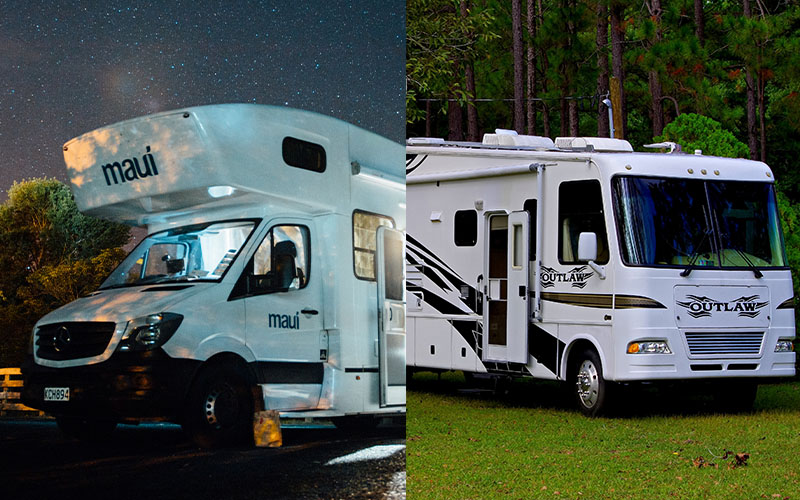When buying a motorhome, you may be wondering if a Class A vs Class C motorhome is safer. Class A vs Class C motorhome safety is complex, as there are many factors that can impact which is safer. Motorhome safety is incredibly important, and although motorhomes are generally just as safe as other road vehicles, there are some considerations that you may want to think through.
In this post, we’ll go through the different factors in Class A vs Class C motorhome safety. Afterwards, you’ll be able to decide which type is best for you and your family!
Table of Contents
ToggleClass A vs Class C Motorhome Safety: Likeliness to Roll
One safety feature to consider is whether or not your RV has a likeliness to roll. Vehicles roll when their center of gravity is disrupted, which is more prolific in vehicles that have a higher center of gravity. Class C motorhomes sit lower to the ground, which means that they are less likely to roll when a turn is taken too sharply or you swerve.
Class A motorhomes are heavier, giving them safety features to prevent rolling. But Class A motorhomes require a different style of driving than a small vehicle or even a Class C motorhome. Much like you can’t take a turn in a pick-up truck the same way you might in a small car, RVs require different driving styles.
Seatbelts
One of the key safety features in any motor vehicle is a seatbelt. If you’re a non-driver in a motorhome, it may be tempting to walk around and not wear your seatbelt, or even lay in a bed, but the safest way to travel in a motorhome is to be seated and seatbelted. If an accident were to occur while passengers were not seatbelted in, they could be thrown into things and seriously injured.
Both Class A and Class C motorhomes have seating areas with seatbelts. Be sure to purchase a motorhome that has as many seatbelts as you plan to have passengers.
Front Impact Accidents
Both features in Class A vs Class C motorhome safety have advantages and disadvantages when it comes to front impact accidents. Let’s take a closer look at the differences!
Class C motorhomes have airbags that deploy in the event of an accident, which provides additional safety features. Class A motorhomes do not have airbags that deploy in the event of a front impact accident, as, typically, Class A motorhomes and their drivers sit higher than other vehicles on the road, providing some additional safety.
In the event of a front-impact collision, Class A motorhomes do not have a large amount of space between the cab and the front of the vehicle, but the additional height provides safety. Class C motorhomes carry the engine in the front, similarly to smaller vehicles, thus providing more space between driver and front of the motorhome.
Visibility
Class A motorhomes sit a lot higher than Class C motorhomes, giving you more visibility. Being able to see farther and wider is helpful in driving, and also makes driving such a large vehicle easier and safer, as you have more time to prepare for the road ahead.
Class C motorhomes are lower to the ground and feel more like driving a truck. Although you have less distance visibility that a Class A motorhome, you are able to better see directly in front of you. When driving a Class A motorhome, be sure to check directly in front of your motorhome before getting in and driving, as it can be difficult to see the first couple feet in front of your motorhome.
Driving Capabilities
Driving a motorhome will always take some getting used to, and each motorhome is different and requires a different approach. Class A motorhomes are larger, have a shorter turning radius, and sit much higher. This can be intimidating to a new driver as it requires slowing down much more to turn and giving yourself lots of space. Once you get used to driving a motorhome, though, many owners say they prefer a Class A as it is completely different from a truck or car, allowing them to switch into “motorhome driving mode” easier.
Class C motorhomes are smaller and often feel more like driving a regular vehicle, as they are lower to the ground and have a tighter turning radius. This can be helpful as you get used to driving a motorhome, but you have to make sure you remember they are still different from driving a regular vehicle.
Class A vs Class C motorhome safety can be tricky to determine which vehicles are truly safer; however, the most important thing to remember is that a motorhome is only as safe as the person driving it! Be sure you are comfortable with driving your motorhome, and take every safety precaution.
Grove RV proudly boasts a large selection of both Class A Motorhomes and Class C Motorhomes at our Spruce Grove location, minutes west of Edmonton.
Still have a few questions about RV maintenance or choosing the right RV for your family? Our team of experienced RV experts would love to speak with you! Get in touch today.



